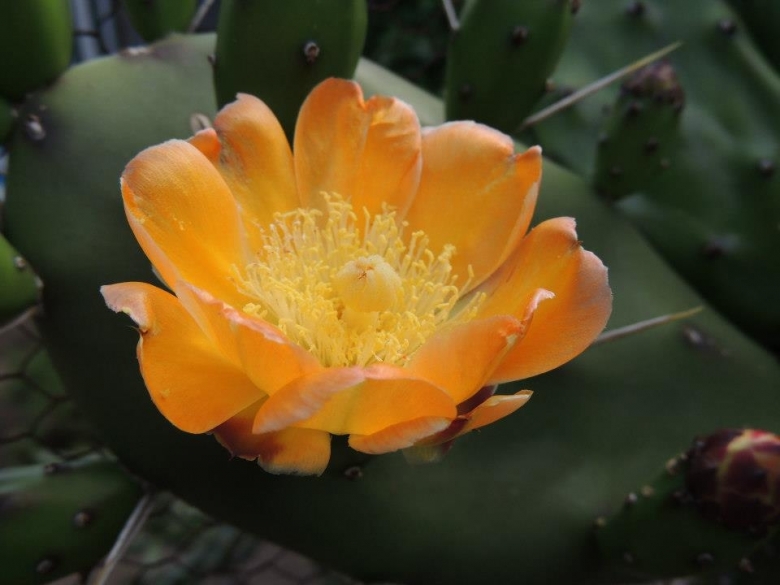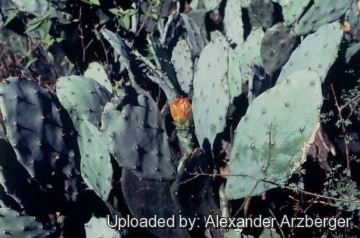
Opuntia elata Photo by: Carolina González
Origin and Habitat: Opuntia elataSN|30934]]SN|30934]] is found in Argentina in Corrientes, Entre Ríos, Buenos Aires, Santiago del Estero, Chaco, Formosa, Córdoba and Santa Fe. It also occurs in Brazil in Rio Grande do Sul and in Paraguay, Bolivia and Uruguay. This species is common and abundant throughout its range.
Altitude range: It grows at elevations between 0 and 500 metres above sea level.
Habitat and Ecology: This cactus occurs in forests and savannas of the Chaco region. It is favored by anthropogenic activities. It is grown for ornament in many tropical and sub-tropical countries and has there escaped from cultivation in gardens to roadsides, fences, waste grounds, disturbed areas (including trails) and riparian systems. It spreads both from seed and from the pads and is invasive in Australia ( New South Wales, Queensland, Victoria and South Australia) and the Mediterranean region. Environmental impacts include loss of biodiversity and habitat change by competing with and replacing native vegetation, damage to environmentally sensitive areas, especially along water courses. Spines and glochids can cause injuries and serious skin irritation or even kill native animals. Clumps of Opuntia elataSN|30934]]SN|30934]] may also arbour foxes and rabbits.
Synonyms:
See all synonyms of Opuntia elata
back
Accepted name in llifle Database:Opuntia elata Link & OttoHort. Dyck. 361 1834Synonymy: 10
Accepted name in llifle Database:Opuntia elata var. cardiosperma (K.Schum.) R.KieslingFl. Ilustr. Entre Rios IVB: 412 2005Synonymy: 3
back
Common Names include:
ENGLISH: Prickly pear, Orange tuna
ITALIAN (Italiano): Fico d'India elevato
SPANISH (Español): Tuna
Description: Opuntia elataSN|30934]]SN|30934]] is a fast growing more or less erect, much-branched shrubby succulent plant and in time can reach 3 metres height and spread, although 1-1.5 metres is more of the common size. The flower is a brilliant deep orange to yellow and appear from late spring throughout summer. The fruit is club shaped and purple-red when ripe. The joints will occasionally exhibit white straight spines up to 3-4 cm long.
Origin of species name: The specific name comes from the Latin adjective “elata”, tall.
Stems: Segments thick, dark green, obovate oblong to spathulate, compressed, (5-)15-25(-30) cm long, (2-)4-9(-15) cm wide, glossy deep green, margin more or less wavy. The trunk is cylindrical and branched.
Leaves: Minute, subulate, falling away early.
Areoles: Widely separated, elongated, large (7 mm. in diameter), filled with short white wool, usually spineless.
Spines: Spines absent, if present only 1 to 3, except on old stems and there more, greyish-white, white-yellowish, rose- or horn-colored, stiff, sometimes 3.5-4(-8) cm long (usually shorter).
Glochids: Wanting in young areoles, later appearing numerous and red-brown, long persistent.
Flowers: Flower-buds rounded at the apex. Flowers rotate, about 3-5(-7) cm broad, orange-yellow to bight orange pollinated by insects. Petals obtuse, broad; filaments short; stigma-lobes white.
Fruits: Oblong, pyriform or club shaped, purple-red, (4-)5-6(-7) cm long, 2-3(-5) cm in thickness, spineless, with a truncate umbilicus.
Seeds: 6 mm broad.
Bibliography: Major references and further lectures
1) Duarte, W., Oakley, L. & Pin, A. 2013. Opuntia elata. The IUCN Red List of Threatened Species. Version 2014.3. <www.iucnredlist.org>. Downloaded on 01 April 2015.
2) N. L. Britton, J. N. Rose: “The Cactaceae. Descriptions and Illustrations of Plants of the Cactus Family.” Vol I, The Carnegie Institution of Washington, Washington 1919
3) Edward Anderson “The Cactus family” Timber Press, Incorporated, 2001
4) Daniel Guillot Ortiz, Emilio Laguna Lumbreras & Josep Antoni Rosselló Picornell “Flora alóctona valenciana: Familia Cactaceae” Monografías de la revista Bouteloua, 5 Available in: www.floramontiberica.orq revistabouteloua. And on ebook: José Luis Benito Alonso (Jolube Consultor y Editor Ambiental. www.jolube.es) Jaca (Huesca), September 2009.
5) Pignatti S. “Flora d'Italia” (3 voll.) - Edagricole - 1982
6) Tutin, T.G. et al. -“Flora Europaea” second edition - 1993
7) Zangheri P. “Flora Italica” (2 voll.) - Cedam - 1976
8) Euro+Med PlantBase - "The information resource for Euro-Mediterranean plant diversity." Published on the Internet http://ww2.bgbm.org/EuroPlusMed/
9) Il cercapiante - "Immagini e nomi locali di piante vascolari" - Progetto Dryades/KeyToNature, coordinato dal Dipartimento di Scienze della Vita dell’Università di Trieste - http://dbiodbs.units.it/carso/cercapiante01
10) Sandy Lloyd and Andrew Reeves “Situation Statement on Opuntioid Cacti (Austrocylindropuntia spp., Cylindropuntia spp. and Opuntia spp.”) in Western Australia. Western Australian Agriculture Authority, Invasive Species Program, DAFWA 31 March 2014
11) Acta Plantarum - http://www.actaplantarum.org/
 Opuntia elata Photo by: Alexander Arzberger
Opuntia elata Photo by: Alexander ArzbergerSend a photo of this plant.The gallery now contains thousands of pictures, however it is possible to do even more. We are, of course, seeking photos of species not yet shown in the gallery but not only that, we are also looking for better pictures than those already present.
Read More... Cultivation and Propagation: Opuntia elataSN|30934]]SN|30934]] is a low maintenance plant that tolerate considerable neglect and will naturalize. Easy to cultivate outdoor in dry, sandy or gravely, well-drained soils. May be grown in clay soils as long as drainage is good and soils do not remain wet, it is very adaptable both in acid, neutral and basic (alkaline) soils, but prefers a pH in the range 6 to 7.5. No serious insect or disease problems.
Watering Needs: Must be kept fairly dry in winter but likes a reasonable supply of water in the growing season, tolerate dry condition but suffer if exposed to prolonged and severe drought. A position at the base of a south-facing wall or somewhere that can be protected from winter rain is best for this plant, but is however resistant to moisture and rain.
Sun Exposure: Full sun (only), in semi shaded position wont produce many flowers.
Frost Tolerance: Plants are reasonably cold-hardy, tolerating temperatures of -5° to -10° C (depending on clone), they are also quite tolerant of winter wet. (In good drained soils).
Use and Trade: The fruits of this species are used as food at a local scale. Opuntia elataSN|30934]]SN|30934]] is also a useful strong and long lasting grafting stock, it is very successful with big columnar cacti, but it is also used for globular species and for grafting other opuntias too. This plant is reasonably hardy and is a good stock for frost sensitive species like Melocactus.
Propagation: Propagated by cuttings of leaf pads at any time in the growing season.











